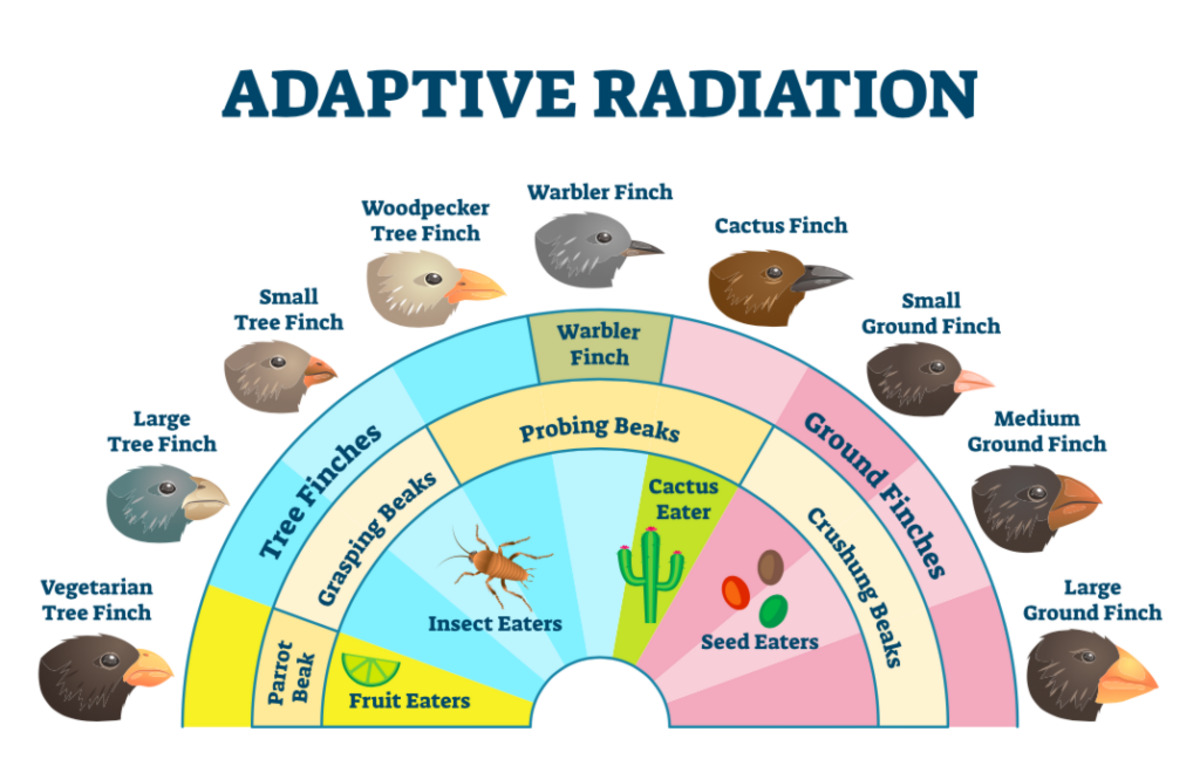
Adaptive radiation is a fascinating phenomenon in the world of biology that has shaped the diversity of life on our planet. It refers to the rapid diversification of a single ancestral species into a variety of new species, each adapted to different ecological niches. Understanding adaptive radiation gives us a glimpse into the remarkable evolutionary processes that have shaped the world we live in today.
In this article, we will explore 19 astounding facts about adaptive radiation. From the remote islands of Galapagos to the ancient forests of Madagascar, we will dive into the intriguing mechanisms behind this evolutionary phenomenon. Get ready to uncover the secrets of how organisms have adapted, diversified, and conquered various habitats throughout history.
Key Takeaways:
- Adaptive radiation is like a species makeover party! When one species diversifies into many, it’s like trying on different outfits to fit into new environments and find the best style for survival.
- Imagine a big family reunion where everyone looks different but shares the same genes. That’s adaptive radiation! It’s like a family tree branching out into unique shapes and sizes to thrive in different places.
What is Adaptive Radiation?
Adaptive radiation refers to the diversification of a single ancestral species into a multitude of different species, each occupying a unique ecological niche. It is a key mechanism for species to adapt to new environments and exploit available resources.
Key Drivers of Adaptive Radiation
Adaptive radiation is often triggered by environmental changes, such as the availability of new habitats, colonization of new territories, or the extinction of competitors.
Rapid Speciation
Adaptive radiation can result in rapid speciation, where new species emerge in a relatively short period of time. This process is driven by natural selection and genetic adaptations to specific ecological niches.
Multiple Ecological Niches
Adaptive radiation allows species to exploit multiple ecological niches within a given environment, leading to increased biodiversity and ecological complexity.
Galapagos Finches
One of the most famous examples of adaptive radiation is the Galapagos finches studied by Charles Darwin. These finches diversified into different beak shapes and sizes to adapt to various food sources on different islands.
Hawaiian Honeycreepers
The Hawaiian honeycreepers are a group of birds that underwent extensive adaptive radiation in the isolated Hawaiian Islands, resulting in over 50 different species with unique beak shapes and feeding behaviors.
Australian Marsupials
Australia is home to a remarkable example of adaptive radiation, with marsupials filling ecological niches that are occupied by placental mammals in other parts of the world. Kangaroos, koalas, and wombats are among the diverse marsupial species found in Australia.
Cichlid Fish in African Rift Lakes
The cichlid fish in the African Rift Lakes, such as Lake Malawi and Lake Tanganyika, have undergone extensive adaptive radiation, resulting in hundreds of different species with unique color patterns and feeding habits.
Darwin’s Finches in the Galapagos
Upon visiting the Galapagos Islands, Charles Darwin noticed the unique adaptations of finches that allowed them to thrive in different habitats, which provided evidence for the process of adaptive radiation.
Repeated Patterns of Adaptive Radiation
Adaptive radiation has occurred repeatedly throughout the history of life on Earth, leading to the evolution of diverse groups of organisms, such as butterflies, ants, and mammals.
Role of Geographic Isolation
Geographic isolation plays a crucial role in facilitating adaptive radiation by limiting gene flow between populations, allowing for the accumulation of genetic differences and the formation of new species.
Evolutionary Potential
Adaptive radiation showcases the remarkable evolutionary potential of species to adapt and diversify in response to changing environments, leading to the emergence of unique morphological, physiological, and behavioral traits.
Ecological Opportunities
Adaptive radiation occurs when an ecological opportunity arises, providing resources and vacant ecological niches for species to exploit and undergo rapid adaptive diversification.
Extinction and Adaptive Radiation
Mass extinctions can pave the way for adaptive radiation by opening up ecological niches previously occupied by extinct species, allowing new groups to fill those roles and diversify.
Island Archipelagos and Adaptive Radiation
Island archipelagos, like the Galapagos Islands and Hawaiian Islands, often serve as hotspots for adaptive radiation due to their isolation and availability of diverse habitats.
Anolis Lizards in the Caribbean
Anolis lizards in the Caribbean have undergone extensive adaptive radiation, resulting in numerous species with distinct body forms, limb lengths, and patterns of habitat use.
Morphological Specialization
During adaptive radiation, species can undergo morphological specialization, where they develop unique physical traits that allow them to exploit specific resources or habitats.
Convergence and Divergence
Although adaptive radiation often leads to divergence and the evolution of distinct species, convergent evolution can also occur, where unrelated species develop similar traits in response to similar selective pressures.
Ongoing Adaptive Radiation
Adaptive radiation is an ongoing process, with examples of ongoing diversification seen in various groups of organisms, such as Darwin’s finches and cichlid fish.
Conclusion
In conclusion, adaptive radiation is a remarkable phenomenon that has played a crucial role in shaping the diversity of life on Earth. The 19 astounding facts about adaptive radiation highlighted in this article give us a glimpse into the incredible variety of species and the adaptive strategies they employ in response to different ecological niches.From the Galapagos finches to the Hawaiian honeycreepers, adaptive radiation has led to the evolution of unique traits and specialized adaptations that allow organisms to thrive in a wide range of habitats. This process is driven by environmental changes, competition for resources, and genetic variation, leading to the emergence of new species and the filling of vacant ecological niches.Through adaptive radiation, organisms have successfully colonized new environments, explored different modes of existence, and diversified into an abundance of forms and functions. This process continues to shape the natural world, with ongoing examples of adaptive radiation occurring across various taxonomic groups.Understanding adaptive radiation not only provides insights into the intricacies of evolutionary biology but also highlights the amazing capacity of life to adapt and evolve. It is a testament to the incredible diversity and resilience of the natural world.
FAQs
1. What is adaptive radiation?
Adaptive radiation refers to the rapid diversification of a single ancestral species into multiple different species, each adapted to a specific ecological niche or environment.
2. How does adaptive radiation occur?
Adaptive radiation occurs when a population of organisms faces new or changing environmental conditions, creating opportunities for the colonization of new habitats and the exploitation of unoccupied niches.
3. What are some examples of adaptive radiation?
Examples of adaptive radiation include the Darwin’s finches in the Galapagos Islands, the cichlid fishes in the African Great Lakes, and the marsupials in Australia.
4. What drives adaptive radiation?
Adaptive radiation is driven by factors such as environmental changes, competition for resources, and genetic variation within the population.
5. Why is adaptive radiation important?
Adaptive radiation is important because it leads to the evolution of new species and the filling of empty ecological niches. It plays a crucial role in generating and maintaining biodiversity on Earth.
6. Can adaptive radiation occur in humans?
Adaptive radiation is typically observed in species that have high reproductive rates and short generation times. While humans can undergo cultural and technological adaptations, the process of adaptive radiation is not commonly observed in the human population.
7. How long does adaptive radiation take?
The duration of adaptive radiation can vary greatly depending on the ecological opportunities and genetic constraints. Some adaptive radiations have occurred over millions of years, while others have occurred relatively quickly in just a few thousand years.
Adaptive radiation's fascinating facts barely scratch the surface of nature's wonders. Dive deeper into biodiversity and its astounding facets. Uncover evolution's great mysteries and how they shape life on Earth. Explore the unique world of island biogeography and its impact on species development. Each topic offers a captivating journey through the marvels of the natural world, inviting curious minds to expand their knowledge and appreciation for the incredible diversity and adaptability of life on our planet.
Was this page helpful?
Our commitment to delivering trustworthy and engaging content is at the heart of what we do. Each fact on our site is contributed by real users like you, bringing a wealth of diverse insights and information. To ensure the highest standards of accuracy and reliability, our dedicated editors meticulously review each submission. This process guarantees that the facts we share are not only fascinating but also credible. Trust in our commitment to quality and authenticity as you explore and learn with us.


